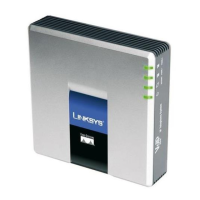Linksys Voice System Administration Guide 75
Managing Inbound Calls with Hunt Groups
Configuring Phone Lines and Calling Routing Behavior
Hunt Group that Rings Stations Individually
You can create a hunt group that rings the stations individually, in sequential order or random
order. You need to set the ring interval and the maximum number of cycles or seconds to occur
before a call is transferred to voice mail.
Syntax for a “Ring Individual Stations” Hunt Group Rule
The syntax for a “ring individual stations” hunt group rule is shown below. Optionally, you can
assign a name to the group.
SYNTAX:
ext-in:name=groupname,hunt-list,type=algo;ring-interval;max,cfwd=ext-fwd
• ext-in (required): The extension number that users dial to contact this group
•
name (optional): The name of the group, which appears in the Corporate Directory on
the phones
•
hunt-list (required): The station numbers that participate in this group, separated by
commas
•
type (required to ring individual stations): The type of routing among the stations in the
group
–
re (sequentially from the beginning): Every incoming call is routed to the first station
in the list. If the call is unanswered, it cycles through the stations in the listed order.
The syntax is
hunt=re.
–
ne (sequentially from the next station): An incoming call is routed by determining
which station most recently answered a call for this group. The new call is routed to
the station that is next in the list. If the call is unanswered, it cycles through the
stations in the listed order. The syntax is
hunt=ne.
–
ra (random): An incoming call is routed randomly to any listed station. If the call is
unanswered, it cycles through the stations in random order. The syntax is
hunt=ra.
•
ring-interval (required to ring individual stations): The number of seconds that elapse
before an unanswered call is routed to another station in the group
•
max (required to ring individual stations): Either the maximum number of cycles or the
total number of seconds that elapse before an unanswered call is forwarded to the cfwd
destination. If the max value is less than the ring interval, it is interpreted as the number
of cycles. If the max value is greater than the ring interval, it is interpreted as the total
number of seconds.
•
cfwd (required to ring individual stations): The Call Forward destination for an
unanswered call. The destination can be another station, a voice mailbox, or the Auto
Attendant.
NOTE: Wildcard characters can be used in the hunt list. Multiple groups can be entered,
using the pipe character as a separator.

